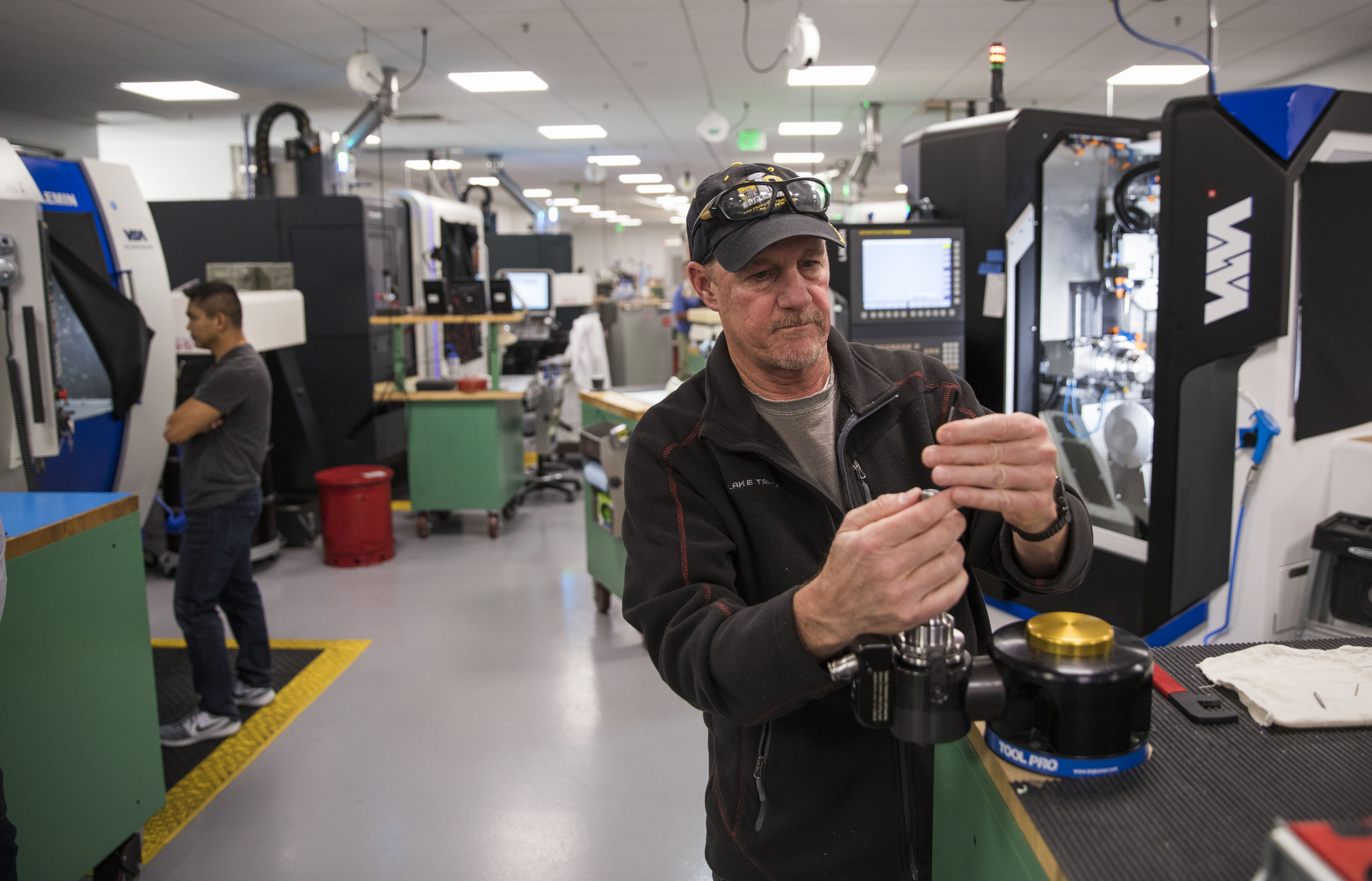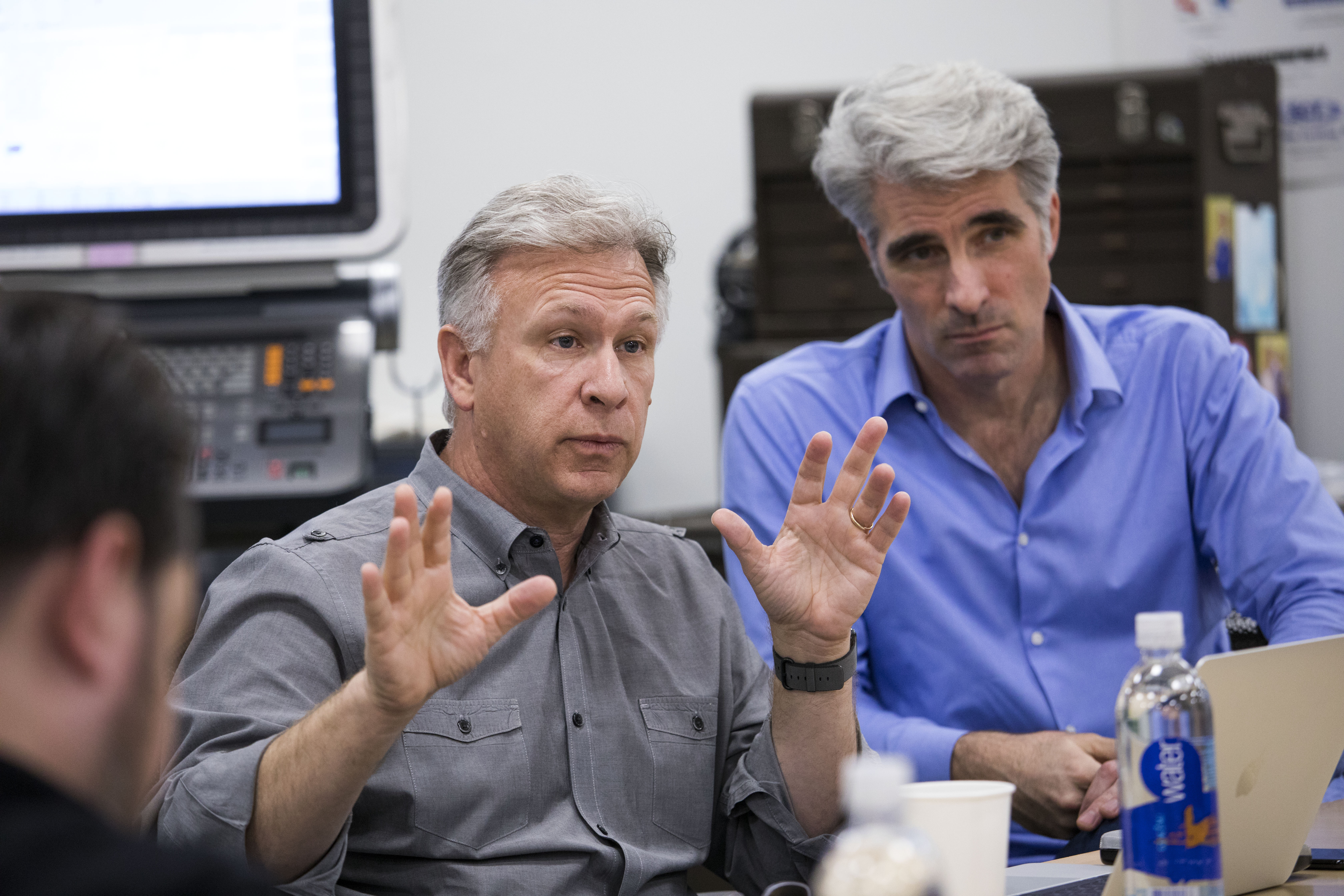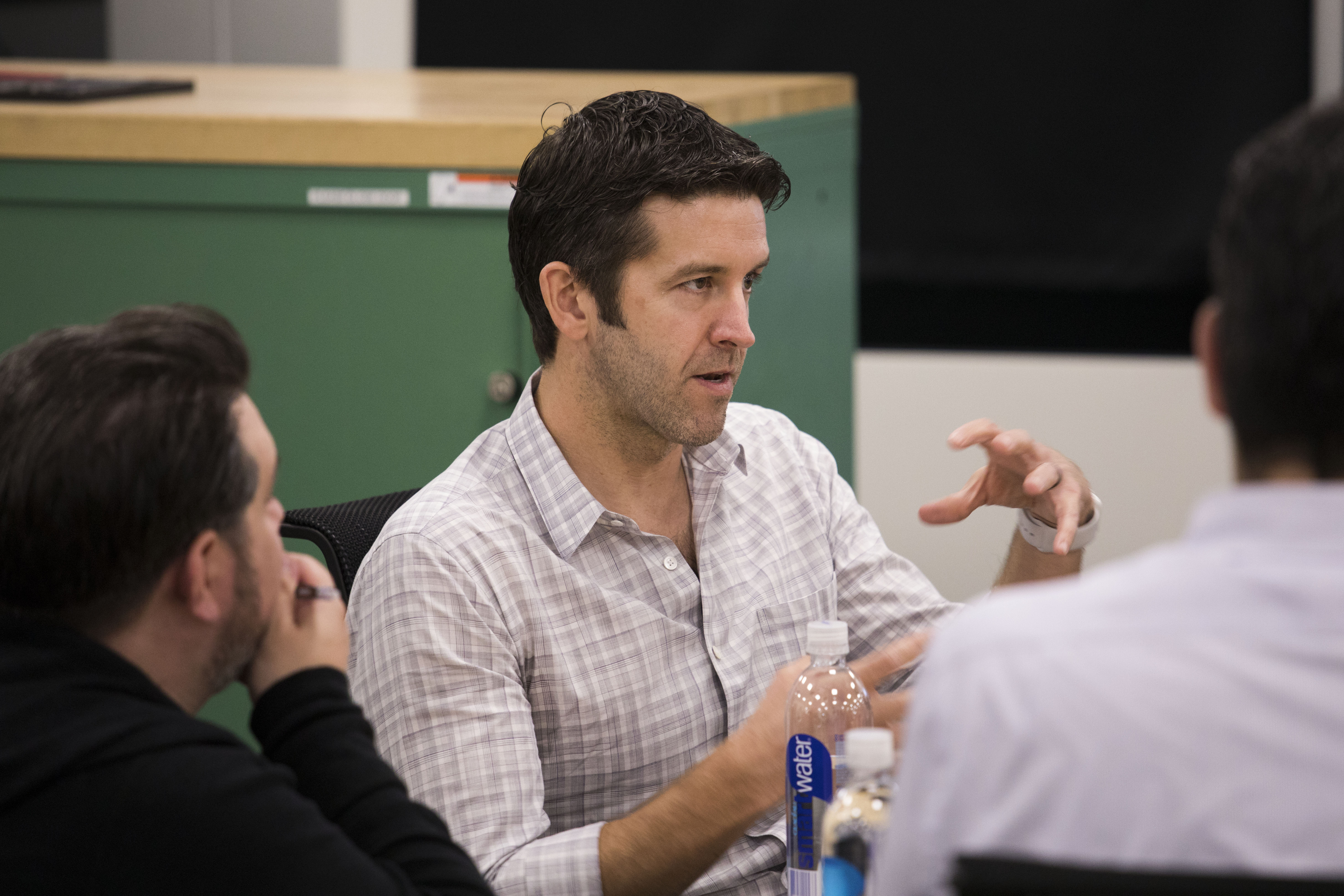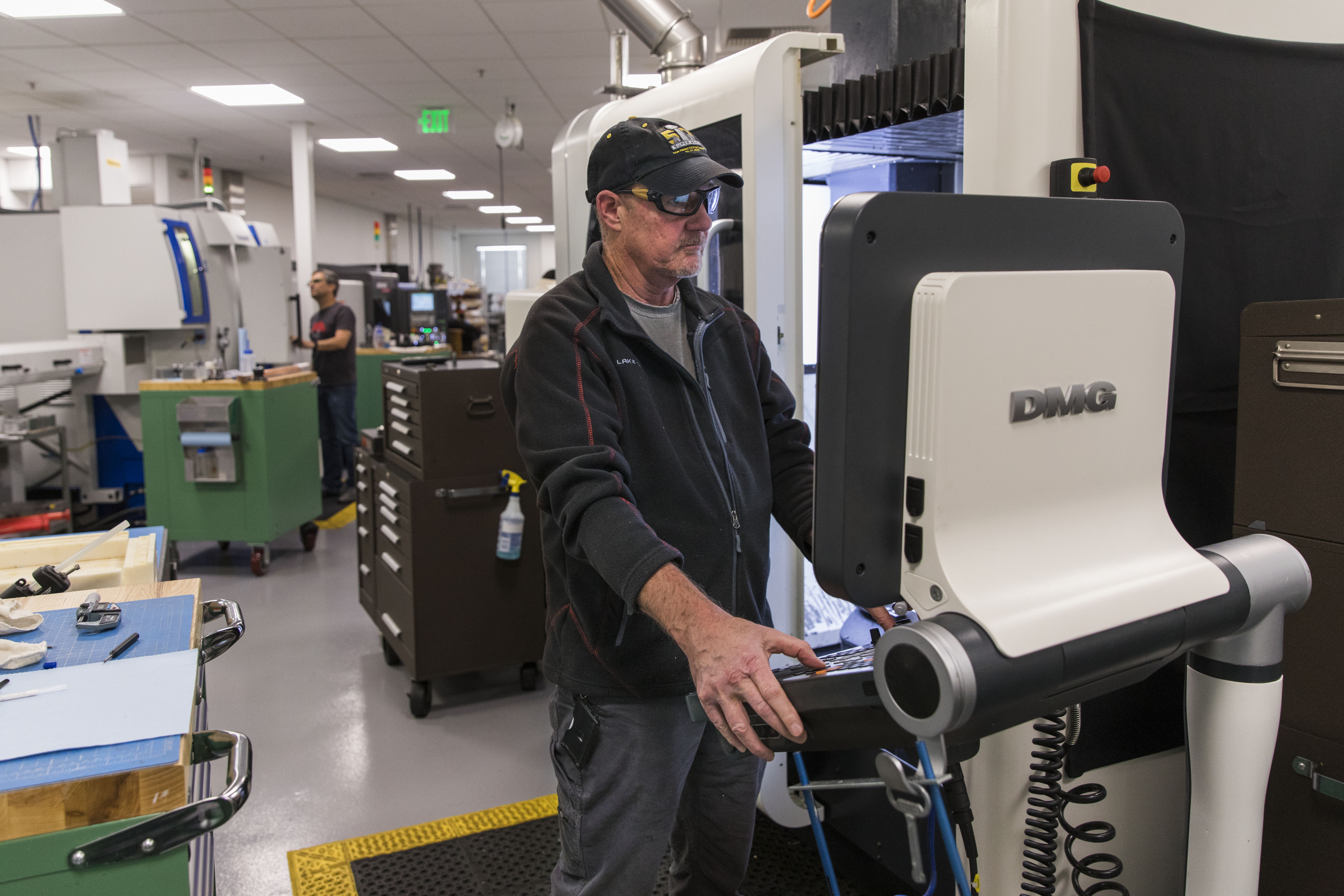“If we’ve had a pause in upgrades and updates, we’re sorry for that — what happened with the Mac Pro — and we’re going to come out with something great to replace it.”
Apple Senior Vice President of Worldwide Marketing Phil Schiller is talking to a small group of reporters in a white stucco building near its headquarters in Cupertino. The purpose of the discussion, while somewhat unclear initially, reveals itself a few minutes in.
The news, if you want it straight: Apple is acknowledging that the Mac Pro they introduced in 2013 has run aground on the cleverness of its own design, and they’re re-thinking the entire machine. In addition, they’ll be releasing a new external display — something it had previously opted out of.
But none of that is coming this year. Today, we’ll see a performance bump on the old design of Mac Pro, which will remain on sale for now. And later this year we’ll see improved iMacs that Apple feels will appeal to a segment of Pro users, as well.
How it got to this point with the Mac Pro is worth exploring, and in an uncharacteristically (at least on the record) open and frank manner, Schiller, Senior Vice President of Software Engineering Craig Federighi and Vice President of Hardware Engineering John Ternus do just that.
Over an hour and a half or so they dissect what went sideways with the Mac Pro, how Apple is addressing pro customers across its product line and yes, dish on future products.
PRL
The low-slung structure sits in one of the many business parks now owned by Apple in the center of Cupertino. People are moving into the splashy new spaceship-like headquarters just miles away as we’re ushered in. This is Apple’s PRL — Product Realization Lab — for the Mac. It’s where Apple crafts prototypes of Mac desktops and laptops to test theories about their design and usability. The lobby features a display of Macs from many eras of Apple. From the solid chunk of aluminum mocking up the slim 12” MacBook to a yellowing plastic rough of a Performa. All flanking the 20th Anniversary Mac famously sketched out by Jony Ive before he was head of all things design at Apple.

Many of the machines have black drapes pulled over the windows, hiding the components being crafted inside. The low-slung conference table in the center of the second room we enter seems out of place. This is a place for doing, not talking, but seated there are the three people at Apple most responsible for the Mac’s hardware, software and marketing.
Due diligence
To start off the conversation, Schiller begins with a discussion of the Mac’s growth. We’re here, after all, to talk about the Mac lineup.
The context, of course, is that Apple’s dedication to the Mac has taken a bit of a philosophical beating lately among its core professional customers. The narrative is that Apple has not put the resources needed into making the Mac work for pros, has neglected updates and could even be working toward a future where there are no Macs, just iOS devices. That’s the picture you’d get from the think pieces, anyway.
To start with, though, Schiller wants to make sure we know how well Mac is doing as a component of Apple’s business. To do this, he offers some context and some numbers, some of which are new. Hell, I’ll even bold these so if you’re a writer on deadline and you’re combing this piece for relevant stats to break out, you can.

Schiller shares some numbers he says are meaningful to Apple. The Mac user base is nearing 100 million users. As a business, it’s also nearing a $25 billion run rate and is close to being a Fortune 100 company on its own. Apple now ships computers at a ratio of 80 percent notebooks to 20 percent desktop computers, a stat they haven’t updated the public on in some time. MacBook Pro sales have been strong, with 20 percent growth in fiscal Q1 y/y.
Schiller notes that this is an unusual kind of briefing for Apple, and everyone agrees. As he notes, this is in-between new product announcements.
“There’s no black cloth that’s gonna come off something right now,” says Schiller. “That’s not why we’re here. While those moments are really fun, we thought it deserved a moment to talk about the Mac, and particularly, the Mac for our Pro users. We’ll talk about what’s going on and frankly be a little more transparent with some of the things we’re doing, some of the places we’re going, because our pro users desire that and we care deeply about them and we’re dedicated to communicating well with them and helping them understand what we’re doing and what we’re up to. We want to be as transparent as we can, for our pro users, and help them as they make their buying decisions. They invest so much in the Mac, we want to support them, and we care deeply about them. So that’s why we’re here.”
Apple has been talking to its pro users, Schiller says, reaching out, meeting them and trying to understand how they use Apple products and what their actual workflows look like. He says that MacOS is very well received and that pro users tell them they love the workflow and the apps.
But this is more about hardware than it is software. And so, the Quadrant is invoked.
The pro quadrant
“First of all, when we talk about pro customers, it’s important to be clear that there isn’t one prototypical pro customer. Pro is such a broad term, and it covers many many categories of customers. And we care about all of these categories, and there’s a variety of different products those customers want,” says Schiller.
“There’s music creators, there’s video editors, there’s graphic designers — a really great segment with the Mac. There’s scientists, engineers, architects, software programmers — increasingly growing, particularly our App development in the app store. So there are many many things and people called pros, Pro workflows, so we should be careful not to over simplify and say ‘Pros want this’ or ‘don’t want that’ — it’s much more complex than that.“
Fifteen percent of all Mac customers, he says, use “pro” category apps multiple times a week. Basically, they use apps in a professional capacity. Thirty percent of Apple’s Mac customer base use pro apps less frequently than once a week but still do use them. And the vast majority of customers who define themselves as pros use Apple’s notebooks.
Next up, unsurprisingly, is the iMac. iMacs are being used disproportionately by pro users in recent years. Whether that’s due to the pace of updates or to the increased capability and much wider spread of the definition of “pro” is in the air. Likely a combination of both.
A “single digit percentage” — and it’s safe to assume the very low end of that single digit scale — of Apple’s Mac customers are Mac Pro customers.
And then Schiller calmly drops the hammer. “We are in the process of what we call ‘completely rethinking’ the Mac Pro,” he says.
The new Mac Pro
Introduced in 2013, alongside the catchphrase (delivered by Schiller) “Can’t innovate my ass,” the Mac Pro’s current incarnation is an extremely identifiable cylinder, housing a three-sided chassis to which are mounted dual GPUs, processors and memory chips. The design was bold, fresh and clever — but even at the outset it raised questions about its configurability and the longevity of the design. And here we are four years later without a significant update to its capabilities.
“We’re working on it,” says Schiller. “We have a team working hard on it right now, and we want to architect it so that we can keep it fresh with regular improvements, and we’re committed to making it our highest-end, high-throughput desktop system, designed for our demanding pro customers.
“As part of doing a new Mac Pro — it is, by definition, a modular system — we will be doing a Pro display as well. Now you won’t see any of those products this year; we’re in the process of that. We think it’s really important to create something great for our pro customers who want a Mac Pro modular system, and that’ll take longer than this year to do.”
Yes, that’s right, a new Mac Pro and new external Pro display are both on the way. But they won’t be coming this year.
It’s worth noting that, when asked about a touch display here, in the context of efforts like Microsoft’s Surface Studio, Schiller replies “No.”
“That’s a whole other long discussion we can get into, but suffice it to say, it’s not a big need of the Mac Pro customers that we’re trying to address,” he says. “You mentioned again how we’re talking about both the iMac and MacBook — I do think that we have a two-prong desktop strategy with both iMac and Mac Pro, we think are each going to be important for pro desktops.”
So Apple’s path will not lead them down the direction of touch Mac screens, as they’ve stated. Instead, Federighi suggests that making the iPad Pro, which they feel has a better drawing experience, work better with the Mac is the answer.
“We recognize customers often [use both] — we all certainly use both — so we’re really focused on making them work well together,” he says.
“Because we think in many tasks, that’s actually the best solution. So all of our customers should feel free to buy multiple products,” he jokes, laughing. “We encourage that.”
The Mac Pro’s thermal corner
How did we get to this point? The current Mac Pro was introduced as a machine that would fit a variety of needs, that could be updated as those needs expanded and that offered a fairly singular vision of the future of pro desktop computers.
“I think it’s fair to say, part of why we’re talking today, is that the Mac Pro — the current vintage that we introduced — we wanted to do something bold and different,” says Federighi. “In retrospect, it didn’t well suit some of the people we were trying to reach. It’s good for some; it’s an amazingly quiet machine, it’s a beautiful machine… But it does not address the full range of customers we wanna reach with Mac Pro.”
That range of customers that he’s referring to does not include all Mac Pro owners. Some, Apple says, are perfectly happy with the machine and it does exactly what they need. But others, especially those who taxed the graphics processing chip or single-threaded CPU performance, found either the configuration or the speed of updates to be a deal breaker.

Says Ternus:
I think one of the foundations of that system was the dual GPU architecture… and for certain workflows, certain classes of pro customers, that’s a great solution. But… to Phil’s point, “Pro” is so broad that it doesn’t necessarily fit all the needs of all the pros.
The way the system is architected, it just doesn’t lend itself to significant reconfiguration for somebody who might want a different combination of GPUs… That’s when we realized we had to take a step back and completely re-architect what we’re doing and build something that enables us to do these quick, regular updates and keep it current and keep it state of the art, and also allow a little more in terms of adaptability to the different needs of the different pro customers.
Federighi elaborates:
I think we designed ourselves into a bit of a thermal corner, if you will. We designed a system that we thought with the kind of GPUs that at the time we thought we needed, and that we thought we could well serve with a two GPU architecture… that that was the thermal limit we needed, or the thermal capacity we needed. But workloads didn’t materialize to fit that as broadly as we hoped.
Being able to put larger single GPUs required a different system architecture and more thermal capacity than that system was designed to accommodate. And so it became fairly difficult to adjust. At the same time, so many of our customers were moving to iMac that we saw a path to address many, many more of those that were finding themselves limited by Mac Pro through a next generation iMac… And really put a lot of our energy behind that. [But,] while that [upgraded iMac] system is going to be fantastic for a huge number of customers — we want to do more.
Ternus says that the team didn’t fully come to grips with the limitations of this architecture until much later than they’d hoped — though none of the speakers will give an exact timeline. This delay in the shift away from parallelism in the GPU architecture and the decision to re-design a new Mac Pro from scratch means that the new machine will not be arriving this year, and is instead slated to appear some time next year or further out (Apple did not specify).
Specifically, as mentioned a bit above, it was the unique triangular design of the Mac Pro’s thermal core that proved to be the limiting factor. Because it was designed to carry roughly balanced loads of heat on all three sides, it just wasn’t equipped to take on the task of supporting the now incredibly popular single massively powerful GPU configuration.
Simply put, it wasn’t built for one of the three sides of the triangle to get super hot.
Instead, Apple had placed its bet on the future right smack in the middle of the dual GPU camp — it even designed specific frameworks for developers to handle those twin graphics processors. But that leap to parallel GPUs running in tandem simply never happened en masse. And though Apple feels that the current Mac Pro does work well for a certain set of customers, for other applications it was essentially at the end of its ability to “get better.”
I ask who, exactly, the pro customers are that most needed the more powerful GPU in a Mac Pro.
“There’s certain scientific loads that are very GPU intensive and they want to throw the largest GPU at it that they can,” says Federighi. “There are heavy 3D graphics [applications] or graphics and compute mixed loads. Those can be in VR, those can be in certain kinds of high-end cinema production tasks where most of the software out there that’s been written to target those doesn’t know how to balance itself well across multiple GPUs but can scale across a single large GPU.”
I also ask what the moment was like, the turning point at which they knew that the current Mac Pro’s design wasn’t the way forward.
“I wish I could give you the kind of answer you want with that, which is, ‘oh, there was a day and a meeting and we all got together and said X,’ ” says Schiller, “but it rarely works that way.”
“We all went on our own emotional journeys, I’d say,” laughs Federighi. “There were periods of denial and acceptance. We all went on that arc.”
Federighi is careful to note that, while Apple set out do so something new and different with the Mac Pro, “we didn’t start with a shape and say, ‘well, here’s the fastest machine we can put in that box.’ We actually started with a target for performance and came up with what I think was a very clever design of that thermal core and thermal architecture to accommodate what we thought was the right power architecture.”
“What I think we didn’t appreciate completely at the time was how we had so tailor designed that specific vision at the time that in the future we would find ourselves a bit boxed in to a circular shape,” he says.
“We were boxed by a circle,” he jokes.
I ask him what Apple’s philosophy on external GPUs is.
“I think they have a place,” he says, and leaves it at that.
For now, a bump
The new Mac Pro is a ways off. And there are a lot of months between now and that time in which someone for whom the current Mac Pro fits the bill might be willing to buy one, even knowing others are on the horizon. So Apple is going to offer some in-between updates starting today.
“In the interim, we know there are a number of customers who continue to buy them. To be clear, our current Mac Pro has met the needs of some of our customers, and we know clearly not ALL of our customers. None of this is black and white, it’s a wide variety of customers. Some… it’s the kind of system they wanted; others, it was not,” says Schiller.
“In the meantime, we’re going to update the configs to make it faster and better for their dollar. This is not a new model, not a new design, we’re just going to update the configs. We’re doing that this week.”
As of today, $2,999 will get you a 6-core Intel Xeon processor, dual AMD FirePro D500 GPUs and 16GB of memory, and for $3,999, you will now get an 8-core processor and dual D700 GPUs.
Schiller notes that telegraphing these updates, along with the ones coming later, is about adding additional transparency for Apple’s Pro customers, who have felt for some time as if Apple was slowly veering away from the Mac and toward iPad and iPhone.
“We recognize that they want to hear more from us. And so we want to communicate better with them. We want them to understand the importance they have for us, we want them to understand that we’re investing in new Macs — not only new MacBook Pros and iMacs but Mac Pros for them, we want them to know we are going to work on a display for a modular system,” says Schiller.
“We want them to know we’re continuing to invest in MacOS as well as our pro app software for pros… those are things we want to clearly communicate to them,” he continues. “And yes, we want them to know that, while we have not had updates to the current Mac Pro, we’re going to keep it on the price list because there are customers for whom it does work — for the things they need to do… we want to at least make the value of it better while we’re doing that.”
Their desire to communicate these things carefully is telegraphed, of course, in the fact that we’re having this conversation and that you’re reading this. It’s certainly unusual in the recent history of Apple for them to speak so candidly about a failure and reset.
New iMacs
Though not a ton of time was spent on the iMac during our discussion, the point was made several times by Federighi that Apple sees the iMac as absorbing a certain portion of the pro populace who finds what it is capable to be enough for them.
To facilitate this, Apple will be introducing new iMacs this year with unspecified spec bumps that will make them more attractive to those pro users. We don’t know exactly when they’re coming, but they’re being worked on now.
Does Apple care about the Mac anymore?
That question is basically the reason that we’re here in this room. Though Apple says that it was doing its best to address the needs of pro users, it obviously felt that the way the pro community was reacting to its moves (or delays) was trending toward what it feels is a misconception about the future of the Mac.
“The Mac has an important, long future at Apple, that Apple cares deeply about the Mac, we have every intention to keep going and investing in the Mac,” says Schiller in his most focused pitch about whether Apple cares about the Mac any more, especially in the face of the success of the iPhone and iPad.
“And if we’ve had a pause in upgrades and updates on that, we’re sorry for that — what happened with the Mac Pro, and we’re going to come out with something great to replace it. And that’s our intention,” he says, in as clear a mea culpa as I can ever remember from Apple.
Federighi continues:
“We certainly see, as I know you do, a wide spectrum of views expressed in internet forums about all things, including our products. I think it’s not entirely unreasonable and it’s understandable that some people who love their Macs so much and see something new that Apple is talking about in the form of iPad, creating in some of them a sense of insecurity: ‘What does this mean? There’s a thing I really care about, I don’t want to see it go away, I see this other new thing on the scene, what does this mean to me, what does this mean to the product I love?’ So I understand how that would come out in the form of concern that this is happening, but this is not happening. The Mac is — we say it over and over, we’re saying it again here — a huge part of our future, we’re deeply invested in it.”

“It’s a reasonable question, and this is why we’re here today, specifically, to address that question above all else. We’re committed to the Mac, we‘ve got great talent on the Mac, both hardware and software, we’ve got great products planned for the future and as far as our horizon line can see, the Mac is a core component of the things Apple delivers, including to our Pro customers.
We’re really serious about this idea that we wanna figure out how to better communicate with pros. We understand their jobs rely on this stuff, they make important decisions about this stuff — they need to hear from us. We do have a process we need to go through, to make products and not tell competitors what we’re doing and on and on. But we’re trying to have it not all be one-way and find the right balance there.”
With that, our conversation wraps up with some small talk. Only a couple of times during the discussion do the executives ask to go off the record to clarify something. It’s surprising how animated they get at these points, and you get the sense that they are weighing every word.
As representatives of the largest company on the planet, it’s not shocking that they need to consider how everything they say could be interpreted both by users and by the market. But it does highlight the difficulty of the balancing act they’re trying to pull off. Having a dialog with pro users (and other users) is healthy in the long run, and seeing Apple make an attempt at this is gratifying. On the other hand, I definitely get the impression that scaling from an audience of five to millions with that dialog is very much an experiment.
As we file out of the building, I can hear the whine of machines beginning to carve away on the next generation of Macs, now promised explicitly for the first time ever.
Thanks to Greg Kumparak, Brian Heater and Anthony Ha for transcription work.
Update: After reviewing my transcript of the conversation, I’ve made a couple of small edits to this story because I don’t believe Apple ever explicitly said the Mac Pro would come next year specifically. It may, but they never said it even though it was mentioned in questions by the press attending. I’ve clarified the times in this piece I mention a timeline to reflect that.































Comment